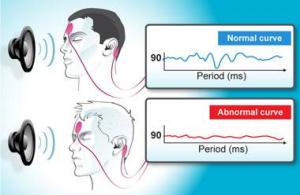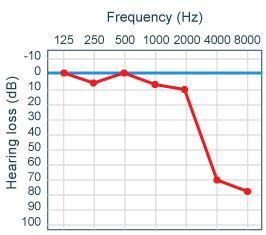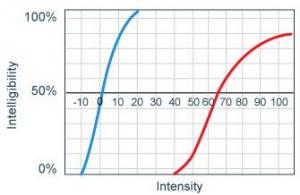Tous droits réservés © NeurOreille (loi sur la propriété intellectuelle 85-660 du 3 juillet 1985). Ce produit ne peut être copié ou utilisé dans un but lucratif.
Detection consists of actively searching for people with hearing loss. In order to do this, different tests are carried out that may or may not require a response from the subject. These tests aim to quickly and accurately diagnose potential illnesses to enable targeted treatment and rehabilitation depending upon the hearing loss, age or other associated problems.
Age-dependent detection
| |
From birth, the search of a hearing loss can be automated and carried out quickly and painlessly to determine children that are at high risk. Some European countries even carry out systematic post-natal hearing screening tests ! |
School nurses are trained to detect hearing problems during routine check-ups. Similarly, parents and family doctors that have regular contact with a child are also able to detect potential hearing loss by observing the child's behaviour.
Finally, in adulthood, detection of hearing problems is carried out from the age of 45-50 by occupational medical staff, then preventatively and regularly in high-risk situations (such as loud or military work environments). It will also occur during a visit to an otorhinolaryngologist (eye, ear, nose and throat specialist; ENT). In the case of adults with cognitive difficulties, early intervention with treatments for hearing loss could postpone the evolution of the neurological illness.
The study of hearing
Oto-acoustic emissions (OAEs)
The first detection test, used at birth, this test is quick and painless. An earphone-sized receptor, placed in the ear canal, collects information that indicates the functional state of certain sensory cells that are essential for hearing. A negative response in this test must be confirmed to enable a diagnosis of hearing loss, and particularly to determine its severity.
These tests can be analysed automatically when used to detect a loss, or manually to determine a precise diagnostic of the type and the severity of the hearing loss.
In adults and children older than five, this can be carried out in a more exhaustive and precise way, as the subject has more understanding and is more able to concentrate on the instruction to indicate whether a sound is heard or not. Commonly, studied frequencies vary from 125 Hz (low) to 8000 Hz (high).
Tonal audiometry is also used from schools to the work place as it can reveal individuals that may be suffering from a hearing loss.
Note. Each of these tests informs about hearing condition in a different way. As a result, the ENT doctor combines their results in order to make the most accurate diagnosis.
Level of hearing loss
Hearing tests (the most common of which have just been described) allow us to characterise the type (see ' What is a hearing loss') and severity of a hearing loss.
The classification of the level of hearing loss has been determined by the international bureau of audiophonology. It is obtained by the averaging hearing thresholds at the frequencies 500 Hz, 1000 Hz, 2000 Hz and 4000 Hz. For example, the degree of hearing loss of a patient with a threshold is that shown in the 'tonal audiometry' section (above) is: (0+5+10+70)/4=21.25 dB. This represents a mild hearing loss.
| |
|
Note that a hearing loss is never measured in percent (%), but in dB of hearing loss! Saying that you have a hearing loss of 50 % doesn't actually mean anything.
Instead, you should say that you have a hearing loss of 50 dB. That aside, it is important to state that the level of hearing loss cannot be limited to this mathematical measure: it needs to take into account the auditory handicap and how disruptive it is to the patient and their loved ones.
 Français
Français
 English
English
 Español
Español
 Português
Português







Facebook Twitter Google+